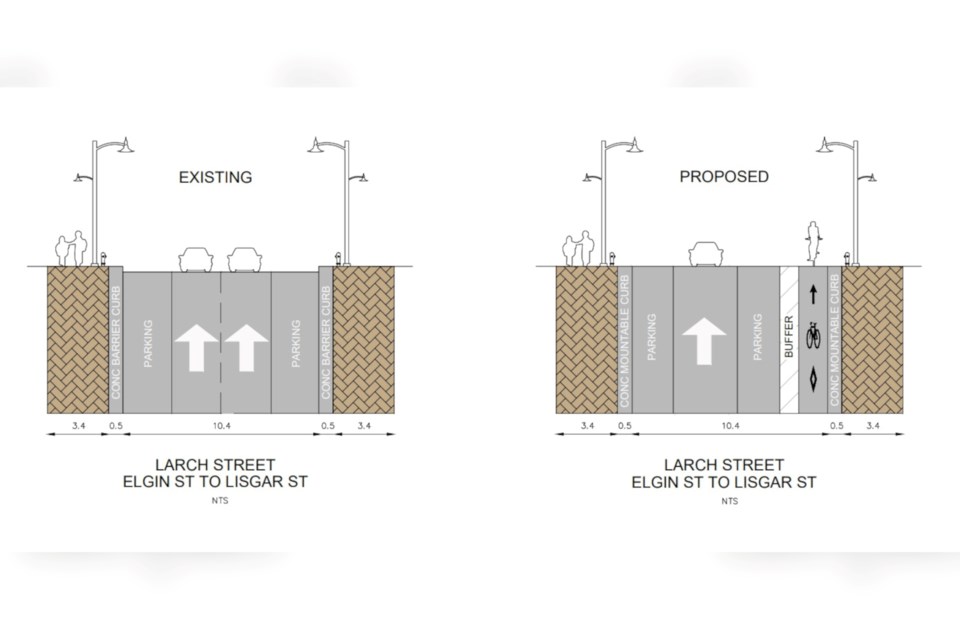The city inched closer to its cycling infrastructure goals this year by adding 9.5 kilometres of cycling lanes, bringing Greater Sudbury’s new total to 149 kilometres.
Although this marks a significant jump from the 21 lane kilometres the city recorded when its Transportation Master Plan was adopted in 2016, it remains shy of its 268-kilometre target.
This year’s 9.5-kilometre jump in cycling infrastructure excludes a section of the Paris-Notre Dame Bikeway worked on this year, which city Active Transportation co-ordinator LyAnne Chenier said isn’t quite completed, but would be done next year and contribute to the 2025 total.
The Paris-Notre Dame Bikeway project began in 2016 and is slated to ultimately stretch from north of Lasalle Boulevard at Turner Avenue, south 8.76 kilometres to the Four Corners.
The project’s current leg started last year, and reaches 2.83-kilometres south from Wilma Street south to John Street, including a 500-metre stretch of the Bridge of Nations.
Wilma Street to Leslie Street was completed last year, and the balance of the 2.83-km leg of the project is slated to be done in 2025 and bring it past its halfway point.
As for the remaining gaps, which include a section north of Lasalle Boulevard and from John Street south to the Four Corners, Chenier said construction will depend on when funding comes through. Classifying the project’s completion as a “longer-term goal,” Chenier said funding hasn’t been identified.
As for the 9.5 kilometres completed this year, Chenier’s report to Monday’s operations committee meeting of city council outlined it as follows:
- Walford Road, from Paris Street to Regent Street (1.39 km)
- Larch Street, from Elgin Street to Lisgar Street (0.25 km)
- The Kingsway, from Barrydowne Road to Falconbridge Road (0.95 km)
- Municipal Road 80, from Main Street to 250 metres south of MacKenzie Street (0.25 km)
- Nelson Street bridge, from Edmund Street to Elgin Street (0.1 km)
- Madison Avenue (2.6 km)
- Gary Street, from Lasalle Boulevard to the end of Gary Street (2.4 km)
- Paquette Street, from Lasalle Boulevard to Lamothe Street (1.5 km)
A few of these projects stick out as unique, such as Walford Road, where speed humps were installed alongside a raised crossover.
“This is our first one for Sudbury,” Chenire told Sudbury.com, adding that they’ve been installed in other communities so there’s precedent. It’s essentially a crosswalk on a speed hump.
A new street design debuted on Larch Street, which was narrowed to one lane of traffic, with parking on one side and a loading zone and bicycle lane on the other. The loading zone separates the lane of traffic from the bicycle lane, which hugs the curb.

It’s a cross-section unique for Sudbury, and has caused some confusion.
“Those line paintings went on right at the end of the year,” Chenier said.
“I think with the snow and the fact that it came at the end of the season with the painting and now snow’s covering part of it, there seems to be a little bit of confusion as to where to park and where the certain elements are.”
The city is planning an educational effort in the spring to help inform people about the unique cross-section and how to use it.
It remains to be seen whether provincial Bill 212, called “Reducing Gridlock, Saving You Time Act, 2024,” will impact the Larch Street project. The legislation, which received royal assent on Nov. 25, aims to limit situations where lanes of traffic are eliminated to make way for bike lanes, but city Linear Infrastructure Services director Joe Rocca told Sudbury.com last month that Larch Street no longer needed two lanes for vehicular traffic.
The street was originally designed during a time in which there was a lot more traffic downtown, he said, and current traffic volumes no longer justify two lanes, he said, adding that he’s not concerned about the province putting a kibosh on the street redesign.
This year also saw the city install approximately 0.9 kilometres of new sidewalk, including:
- Crescent Avenue, from Vaughan Avenue to Ormsby Avenue (150 metres)
- Ormsby Avenue, from Crescent Avenue to Dennie Street (100 metres)
- Anderson Drive, from Municipal Road 25 to Meagan Duhamel Drive (300 metres)
- Municipal Road 80, from Main Street to 250 metres south of MacKenzie Street (350-metre multi-use path)
Next year’s capital budget includes more cycling infrastructure, though Chenier said the specific scope of each cycling project is still being hashed out.
Tyler Clarke covers city hall and political affairs for Sudbury.com.



